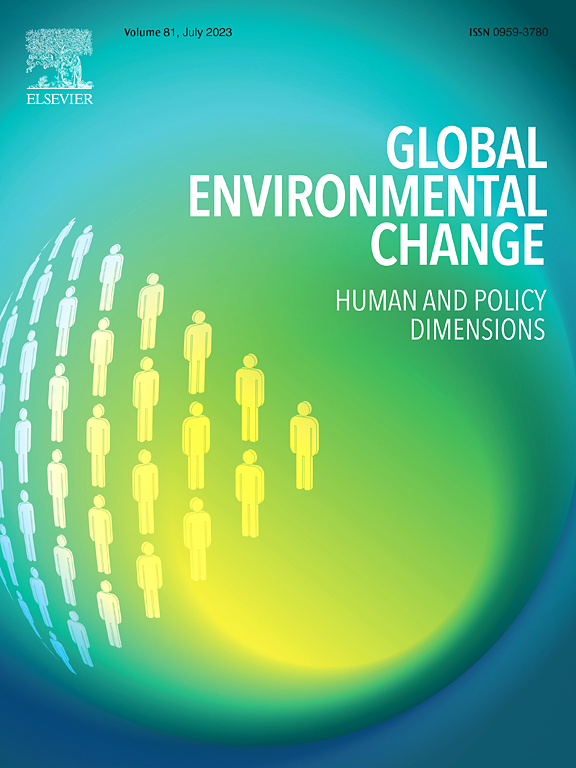The history of a + 3 °C future: Global and regional drivers of greenhouse gas emissions (1820–2050)
IF 9.1
1区 环境科学与生态学
Q1 ENVIRONMENTAL SCIENCES
引用次数: 0
Abstract
Identifying the socio-economic drivers behind greenhouse gas emissions is crucial to design mitigation policies. Existing studies predominantly analyze short-term CO2 emissions from fossil fuels, neglecting long-term trends and other GHGs. We examine the drivers of all greenhouse gas emissions between 1820–2050 globally and regionally. The Industrial Revolution triggered sustained emission growth worldwide—initially through fossil fuel use in industrialized economies but also as a result of agricultural expansion and deforestation. Globally, technological innovation and energy mix changes prevented 31 (17–42) Gt CO2e emissions over two centuries. Yet these gains were dwarfed by 81 (64–97) Gt CO2e resulting from economic expansion, with regional drivers diverging sharply: population growth dominated in Latin America and Sub-Saharan Africa, while rising affluence was the main driver of emissions elsewhere. Meeting climate targets now requires the carbon intensity of GDP to decline 3 times faster than the global best 30-year historical rate (–2.25 % per year), which has not improved over the past five decades. Failing such an unprecedented technological change or a substantial contraction of the global economy, by 2050 global mean surface temperatures will rise more than 3 °C above pre-industrial levels.
未来+ 3°C的历史:温室气体排放的全球和区域驱动因素(1820-2050)
确定温室气体排放背后的社会经济驱动因素对于制定缓解政策至关重要。现有的研究主要分析化石燃料的短期二氧化碳排放,而忽略了长期趋势和其他温室气体。我们研究了1820-2050年间全球和区域所有温室气体排放的驱动因素。工业革命引发了全球持续的排放增长——最初是由于工业化经济体使用化石燃料,但也由于农业扩张和森林砍伐。在全球范围内,两个世纪以来,技术创新和能源结构变化阻止了31亿吨二氧化碳当量的排放。然而,与经济扩张产生的81亿吨(64-97亿吨)二氧化碳当量相比,这些收益相形见绌,区域驱动因素差异很大:人口增长在拉丁美洲和撒哈拉以南非洲占主导地位,而富裕程度的提高是其他地区排放的主要驱动因素。要实现气候目标,GDP碳强度的下降速度必须比全球30年历史最佳速度(每年- 2.25%)快3倍,而过去50年这一速度并没有改善。如果没有这种前所未有的技术变革或全球经济大幅收缩,到2050年,全球平均地表温度将比工业化前水平上升3°C以上。
本文章由计算机程序翻译,如有差异,请以英文原文为准。
求助全文
约1分钟内获得全文
求助全文
来源期刊

Global Environmental Change
环境科学-环境科学
CiteScore
18.20
自引率
2.20%
发文量
146
审稿时长
12 months
期刊介绍:
Global Environmental Change is a prestigious international journal that publishes articles of high quality, both theoretically and empirically rigorous. The journal aims to contribute to the understanding of global environmental change from the perspectives of human and policy dimensions. Specifically, it considers global environmental change as the result of processes occurring at the local level, but with wide-ranging impacts on various spatial, temporal, and socio-political scales.
In terms of content, the journal seeks articles with a strong social science component. This includes research that examines the societal drivers and consequences of environmental change, as well as social and policy processes that aim to address these challenges. While the journal covers a broad range of topics, including biodiversity and ecosystem services, climate, coasts, food systems, land use and land cover, oceans, urban areas, and water resources, it also welcomes contributions that investigate the drivers, consequences, and management of other areas affected by environmental change.
Overall, Global Environmental Change encourages research that deepens our understanding of the complex interactions between human activities and the environment, with the goal of informing policy and decision-making.
 求助内容:
求助内容: 应助结果提醒方式:
应助结果提醒方式:


